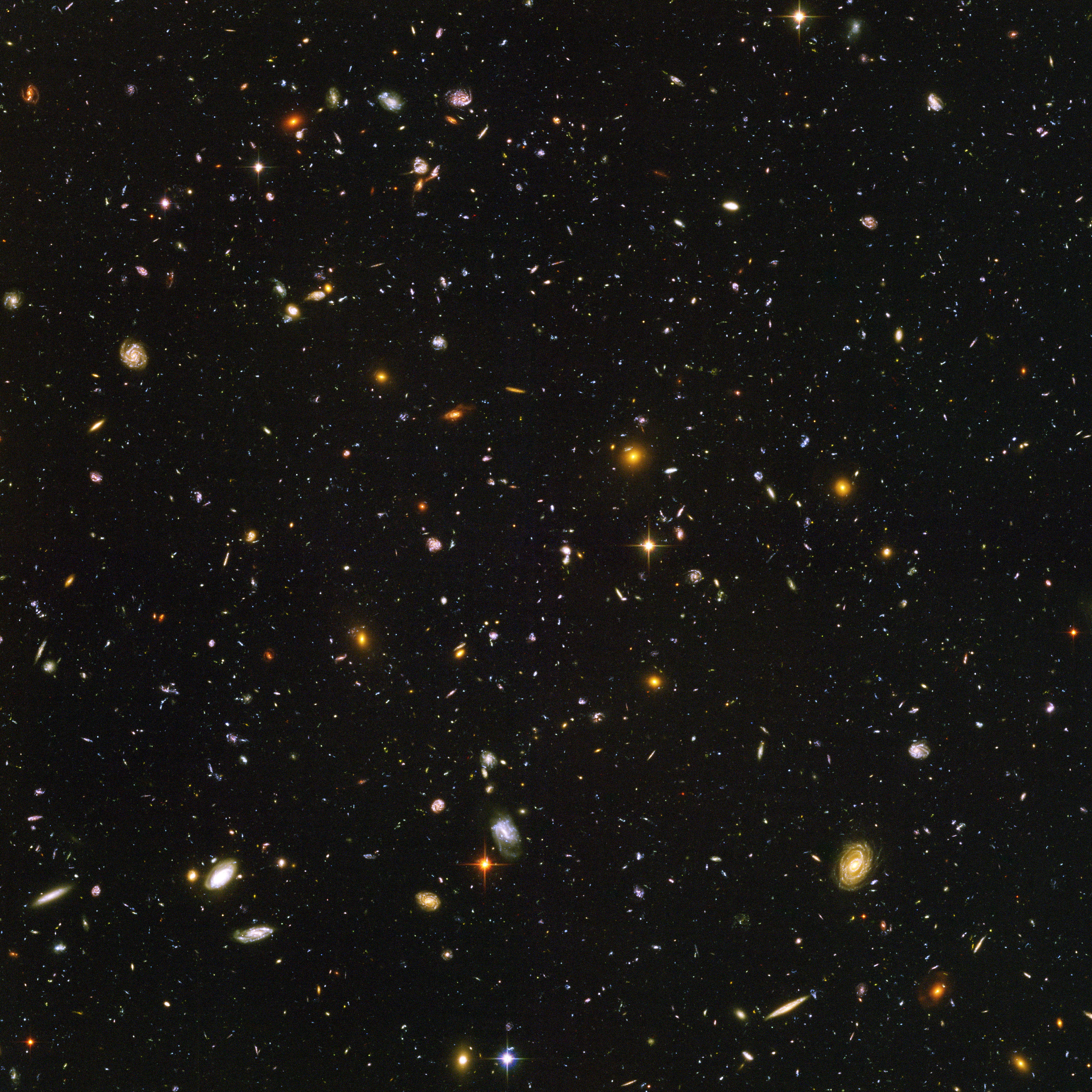Humanity has long wondered about the existence of extraterrestrial civilizations. With more advanced technology and the advent of the Space Age, the question became a scientific topic. It is widely believed that there is the potential for life to develop in other parts of our galaxy, which is why space probes were launched to search for signs, or at least the basic components of life in other parts of our solar system (for example, on Mars, or Saturn's moon Titan, and in Venus's atmosphere where not long ago phosphate compounds were found that may indicate simple forms of life).
Where is everybody?
One of the best, or at least the most notorious, debates about extraterrestrial life took place in 1950 at lunch in the cafeteria of the Jet Propulsion Lab at Los Alamos. The physicists Enrico Fermi, Emil Konopinski, Edward Teller, and Herbert York were present. Fermi, known for his method of so rapidly calculating complex mathematical puzzles that it sometimes seemed as if he were shaking numbers out of his sleeve, flipped through a magazine (supposedly it was The New Yorker) and spotted a cartoon featuring space aliens turning over garbage bins and exclaiming: "Where is everybody?" None of the participants remember exactly how the conversation went (Howell 2018), but most agree that the question focused on the possibility of space travel (at that time Sputnik was seven years in the future, Gagarin's trip eleven years). Fermi's question later evolved into Fermi's paradox where it no longer had to do with the question of how to travel through space (a human team has now managed to get to the moon, but that took several days, to Mars it took about a half a year, to the nearest star of Alfa Kentaur, according to NASA data, it would take about 73,000 years), but why we have not yet discovered the existence of any extraterrestials, despite the fact that there are billions of stars and planets in our own galaxy that have the conditions to sustain life.
Decades after that famed conversation, the American astronomer and astrophysicist Frank Drake attempted to respond to Fermi's paradox with a more structured evaluation of the number of developed extraterrestrial civilizations in our galaxy (Drake and Sobel 1994). Drake's equation, which determines the probable number of civilizations in our galaxy, is a simple product of the average rate of star formation in our galaxy, the fraction of those stars that have planets, the average number of planets that can potentially support life per star that has planets, the number of planets in the same systems on which life could emerge, the fraction of planets with life that actually go on to develop intelligent life, the fraction of civilizations that develop technologies that can emit detectable signs of their existence into space. The product is dependent on the estimation of the inputs and many critics of the equation have emphasized its unreliability. But the upper estimate calculated in this way is around fifteen millions, which means that, in our galaxy alone, there should be millions of civilizations with which we could establish contact. In its last assessment, NASA, no doubt motivated by the lack of contact with other civilizations, gives a value of N for 9.1 10-13 civilizations, which is practically none.
Although there may be extraterrestrial civilizations in our galaxy, there could also be many reasons that we are prevented from making contact with them. Indeed, a significant part of cosmology, inspired by Fermi’s paradox and Drake's equation, is dedicated to finding the cleverest excuse for failing to have encountered alien civilizations. Some blame logistics, others that intelligent civilizations are too far away and simply do not have the travel or communications technology for such extended distances. This is what the astronomers William Newman and Carl Sagan proposed in 1981. The problem may also be on our side – either our communication capabilities are too limited or our civilization is too young and our electronic fingerprints have not been detected by the right neighbours (similar to what is described in Sagan's second novel Contact). Another possibility is that extraterrestrials are silently observing us to make sure we don't do anything stupid: this is known as the "the zoo hypothesis". Fans of science fiction frequently mention a similarity to Star Trek, where the Federation Starfleet must follow the protocol of the Prime Directive and its prohibition against interfering in less developed civilizations. The alternative is somewhat more depressing – maybe we are simply not interesting enough. The theoretical physicist, Michio Kaku, provided a picturesque metaphor – as a civilization, we are about as interesting as an anthill in Peru during the era of Pizarro's conquest of the Inca Empire. It seems it was this possibility that Douglas Adams, the author of The Hitchhiker's Guide to the Galaxy, had in mind which the Guide describes Earth as "mostly harmless". Perhaps, for the time being, we should disregard more imaginative solutions, for example that our neighbours have successfully transcended everyday life, and its issues of mortality and material needs, or that humanity is merely a hologramic image.
In 1996, the economist Robin Hanson explained the absence of communication with extraterrestrial civilizations with a concept called the Great Filter, which stops the development of a civilization or even destroys it before the civilization can go beyond the limitations of its own planet. The Great Filter is proposed as the main obstacle preventing a potential civilization from skipping some of the phases needed to make use of extra-planetary energies (such steps might include the selection of the right star or planet, reproductive molecules such as DNA, the development of one or more celled beings, the use of tools, industrial advancement, colonization of other worlds, etc.). We have already taken most of these steps on earth, and thus we do not know if we have just been incredibly lucky thus far or whether the Great Filter will limit our development in the future.
Energy as a measure of the development of civilization
In the search for extraterrestrial civilizations, it is useful to evaluate or at least get a sense of the direction of development. In 1964, the Russian astronomer Nikolai Kardashev came up with idea of measuring the development of civilizations based on the energy they are capable of harnessing for their existence (Kardashev scale 2020). The idea is so simple it is fantastic. As a civilization develops, both numerically and productively, it needs increasingly more energy. Given energy limitations in the universe, civilizations can be divided into three types: Type I (planetary civilizations) that successfully use and store all the energy on their own planet, Type II (stellar civilizations) that use and control all the energy at the level of the planetary system, and Type III (galactic civilizations) that can control energy at the level of their entire galactic host system. In the case of earth, the energy levels are as follows (Lemarchand 2000):
● Type I: 1.7 1017 W
● Type II: 4.0 1026 W
● Type III: 4.0 1037 W
By way of comparison, the quantity of energy that humanity used in 2018 was equivalent to 1.8 1013 W, almost ten thousand times less than the range of a Type I civilization. These are relatively big numbers, but for the moment let's look at what they mean from the perspective of visibility at cosmic distances. We have all seen photographs of the earth at night when cities are illuminated by neon and other lights. But this image cannot be perceived beyond the moon's orbit, some 384,000 kilometres away, because the light is too weak. It is estimated that with a good telescope tiny specks of light on the dark side of the earth could be detected from Mars at a distance of about seventy million kilometres.
In the past thirty years, since astronomers discovered exoplanets, over four thousand planets have been found orbiting stars that are not our sun, the great majority in the last few years as a result of the development of powerful telescopes and other technologies. The distance to these planets range from four to almost twenty-eight thousand light years. We cannot determine at this distance if any kind of life that is similar to human life (that is Type 1) exists on any of these planets.
It seems that civilizations that didn't succeed in achieving Type I on Kardashev's scale simply merge with the environment. In particular, we know that the closest exoplanets are several light years away, therefore at least a half million times farther away than Mars. Until now we have not found civilizations that have gone beyond Type I. In this regard, we must also note that the number of the discovered exoplanets are relatively (too) few to satisfy the statistical necessities of the Drake equation, mainly because of the equation's wide range.
To achieve and go beyond a Type I civilization, it is therefore necessary to leave the home planet. One of the methods for collecting sufficient energy in space is a construction that surrounds a mother star, for example a Dyson Sphere, and the use photovoltaic panels to capture the energy of the star. This kind of construction and its effects would of course be visible at great distances. However, while the earth's civilization has during the last sixty years shot several thousand satellites and spacecrafts into space (mostly in the lower orbit of earth), their collective mass does not exceed ten thousand tonnes – which is far less than would be required for a construction such as a Dyson Sphere that would be visible from the other side of the galaxy.
Higher, faster, stronger
To get a feeling of how fast we move along Kardashev's scale (in other words, how quickly we consume available energy), it makes sense to linearize the scale, which brings us back to the previously mentioned Carl Sagan. The linearized value of the level of our civilization is 0.73. Humanity's need for energy has increased over the past three hundred years by approximately thirty-six times, or 0.155 on the (linearized) Kardashev scale, which indicates the very rapid development that started with the beginning of the Industrial Revolution. Most of this growth has taken place in the last century, during which the measure jumped by 0.07. Population growth and energy consumption are the two primary factors that contributed to this jump. An average person today consumes at least fifteen times more than a person during the time of the Roman Empire. In the developed world, that increase may be more than a hundred times. Similarly, the number of people on the planet has also grown – from 180 million to seven and a half billion – a more than fortyfold increase. At this rate, humanity will use up all the energy that defines a Type I civilization in the next few centuries. It would be enough if the entire population wanted to live as luxuriously in terms of energy usage as we do in western consumerist societies.
Great, you might say, we should use just a little bit of energy here, turn on a light there, turn on a big machine around this corner, and we will slowly achieve the level of a higher cosmological civilization. But in his design of the scale, Kardashev used the completely opposite logic. He assumes that energy needs will increase with the growth of development and technological capacities to travel around the solar system and the universe. His parameters do not consider the generation of heat in the earth's core (estimated to be 4.7 1013 W, or 0.3% of the sun's energy). Either naively or with great foresight, he anticipated sustainable development, namely that we do not irreversibly draw down the earth's energy supplies but use only the quantity of energy that the planet is capable of producing.
In order to meet our energy needs, it will be necessary to reach beyond the borders of the planet and the solar system. But this kind of travel is not cheap. The energy needed to transport a kilogram of material into the earth's lower orbit is approximately 30 kWh. To transport a kilogram of material to the moon, approximately 2000 kWh (on the lunar module) is needed, some ten times more than is needed for the transport of trucks along roads. In any case, moving through the universe requires energy, and to get this energy would necessitate both the colonization of the universe and the exploitation of the resource that the sun makes widely available – sunlight.
But we can only use the energy of the sun to a certain degree. Existing technology is subject to the efficiency of photovoltaic panels and additional electronic methods. Although the yield of these contemporary commercial panels has reached and even exceeded 20%, that still means we are only using a fifth of the available energy that the sun sends down onto the surface of the planet. With much of the surface of the earth covered by ocean and/or unsuitable climactic conditions, our ability to harvest energy has become even more limited. Even nature cannot help us significantly in the transformation of energy. Photosynthesis produces minor yields but the best plants in the biomass industry only manage a few percent of what the sun radiates, which is at least ten times less then photovoltaic panels, and then it is necessary to transform the biomass into a more usable form of energy. At the same time, limits on existing space technologies do not yet permit the economic use of solar power away from the earth.
There is another possibility that the Kardashev's scale does not consider – atomic energy. But atomic energy plants function as mere heating units, as two-thirds of the generated energy represents excess heat that is lost (in the end, all of it ends up as heat). If the proportion of excess heat is too great for the earth's balance, this would make the earth an additional (and considerable) 12°C hotter by 2400 (Mullan and Haqq-Misra 2019), meaning that the climate change we see until 2100 will only be a mild overture.
Did extraterrestrials get cooked?
Climate change has shown that our energy needs have also started to affect the planetary climate. At the same time, the lack of other visible civilizations may indicate that climate change, along with other disruptive technological developments, may be a problem not only here on earth, but quite literally a universal problem – that is a problem for all civilizations that tend toward being Type I on Kardashev's scale. At the same time, the energy demands that enable the use of a large share of the energy of the sun or mother star are so great that eventually the development of such civilizations arrives at a dead end.
Similar ideas existed already in the mid-1970s (Hoerner 1975), and were further elaborated in recent years, receiving the strong support of the scientific public (Byers and Peacock 2019). This deadlock in development may dovetail with Hanson's definition of the Great Filter. The contemporary situation in which we find ourselves is a sort of Don Quixote struggle against global warming and climate change that are the result of excessive use of energy. It seems that environmental catastrophe because of the uncontrolled use of energy from the mother planet, may hinder any advanced civilization, including ours here on earth. This theory provides a satisfactory response to Fermi's paradox about the lack of extra-terrestrial civilizations in our surroundings – and at the same time, eliminates the hope that technological advances can be counted on to solve the complex difficulties caused by climate change and the impact on our civilization and life on the planet.
We must not forget that Kardashev's scale emerged during a time of rapid progress in space technology when a moon landing seemed as futuristic as teleporting, a time machine, or a space elevator. However, the actual economic and energy conditions of the last fifty years have shown that such technological leaps are extraordinarily rare. Insight into neighbouring exoplanets show that such leaps are even rarer than we hoped. Because of this, it is only logical to reduce our unrestrained lust for energy and adapt our development with advanced technologies that use less energy and planetary sources and produce less toxins.
Translated by Erica J. Debeljak















